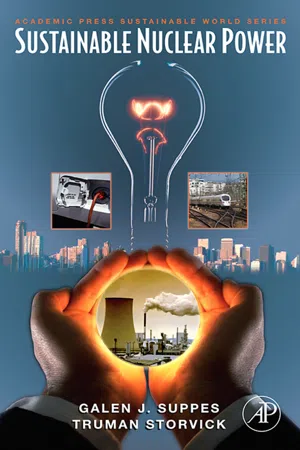Technology & Engineering
Work
Work in the context of technology and engineering refers to the application of force over a distance to accomplish a task. It is a measure of energy transfer and is calculated as the product of force and displacement in the direction of the force. In engineering, work is a fundamental concept used to analyze and design mechanical systems.
Written by Perlego with AI-assistance
Related key terms
Related key terms
1 of 4
Related key terms
1 of 3
3 Key excerpts on "Work"
- eBook - ePub
Physics of Cryogenics
An Ultralow Temperature Phenomenon
- Bahman Zohuri(Author)
- 2017(Publication Date)
- Elsevier(Publisher)
These may be called energy transfer or energy interactions and they bring about changes in the properties of the system. Positive Work occurs when the system transfers energy to its surroundings by some mechanical or electrical process. Positive heat transfer occurs when the surroundings transfer thermal energy to the system. Normally a temperature difference is the driving potential that moves thermal energy into or out of a system.4.2. Definition of Work
The formal definition of Work is “a force acting through a distance.” When a system undergoes a displacement due to the action of a force, Work is taking place and the amount of Work is equal to the product of the force and the displacement in the direction of the force. The term Work is so common with many meanings in the English language that it is important to be very specific in its thermodynamic definition.4.2.1. Work Is Done by a Force as It Acts Upon a Body Moving in the Direction of the Force
If the force acts, but no movement takes place, no Work is done. Work is performed by the expanding exhaust gases after combustion occurs in a cylinder of an automobile engine as shown in Fig. 4.1 . In this case the energy produced by the combustion process can be transferred to the crankshaft by means of the connecting rod, in the form of Work. Therefore, the Work can be thought of as energy being transferred across the boundary of a system, the system being the gases in the cylinder.A similar concept is the Work done in the turbine to generate electricity in a nuclear power plant. The gas pressure rotates the turbine blades producing a torque that turns a generator. Thermal energy is transferred from the reactor core to the steam generator in the first loop. The second loop then uses this steam to drive the turbine. See Fig. 4.2 - No longer available |Learn more
MCAT Physics and Math Review 2024-2025
Online + Book
- (Author)
- 2023(Publication Date)
- Kaplan Test Prep(Publisher)
θ is the angle between the applied force vector and the displacement vector. You’ll notice that Work is a dot product; as such, it is a function of the cosine of the angle between the vectors. This also means that only forces (or components of forces) parallel or antiparallel to the displacement vector will do Work (that is, transfer energy). We’ve already said that the SI unit for Work is the joule. While this suggests that Work and energy are the same thing, remember they are not: Work is the process by which a quantity of energy is moved from one system to another.Pressure and Volume
As described above, Work is a process of energy transfer. In mechanics, we think of Work as application of force through some distance. We will learn in our discussion of fluids in Chapter 4 of MCAT Physics and Math Review that pressure can be thought of as an “energy density.” In systems of gases, we therefore approach Work as a combination of pressure and volume changes. In Chapter 3 of MCAT Physics and Math Review, we’ll examine how these changes also relate to heat.For a gas system contained in a cylinder with a movable piston, we can analyze the relationship between pressure, volume, and Work. When the gas expands, it pushes up against the piston, exerting a force that causes the piston to move up and the volume of the system to increase. When the gas is compressed, the piston pushes down on the gas, exerting a force that decreases the volume of the system. We say that Work has been done when the volume of the system has changed due to an applied pressure. Gas expansion and compression processes can be represented in graphical form with volume on the x-axis and pressure on the y-axis. Such graphs, as shown in Figure 2.2, are termed P–V graphs - eBook - ePub
- Galen J. Suppes, Truman Storvick(Authors)
- 2006(Publication Date)
- Academic Press(Publisher)
Everyone understands that Work is the use of energy to perform a task. It is Work to lift a box from the floor to a table. Shoveling sand or snow is Work. When we carry a bag of groceries from the store to the parking lot, it is Work. All tasks we do that have us moving an object from one place to another we understand to be Work. When we repeat the task several times, we need rest, and we need food to restore the energy we used performing those tasks. This qualitative description forms the basis for the scientific definition of Work.The scientific definition of Work used in physics must be mathematically exact. This is necessary because the numerical value of the Work we assign to a task must be the same for every scientist or technologist who does the analysis. This allows scientists to communicate efficiently. Physics has its own definition of Work: Work is the numerical value of a force multiplied by the distance over which that force is applied. We can use this definition to compute the Work required to lift a box from the floor to a table.The planet Earth exerts a force on all objects near it: the force of gravity. We measure this force in pounds. Where a 10-pound box is lifted the 2 feet from the floor to the top of a table, 20 foot-pounds of Work are done against the force of gravity. If a 10-pound box is lifted 2 feet, 20 foot-pounds of Work are performed.The analysis of the Work one does shoveling snow or sand involves replications. The weight of each shovel of snow times the distance the shovel travels upward against the force of gravity is the Work per full shovel. Multiply the Work per shovel by the number of times you must load the shovel and this is the total amount of Work required to clear the sidewalk. It is more Work to shovel snow into the back of a truck than to shovel snow to the side of the driveway because the truck is higher.If we threw 100 pounds of sand instead of 100 pounds of snow into the truck, the same amount of Work would be required to load snow or sand. This physics definition of Work allows us to calculate the numerical value of the required Work, and the Work is independent of the material we move. We can replace the sand with corn, coal, or cucumbers, but it is the weight in pounds times the height of the truck bed that determines the Work required to load the truck.
Index pages curate the most relevant extracts from our library of academic textbooks. They’ve been created using an in-house natural language model (NLM), each adding context and meaning to key research topics.
Explore more topic indexes
Explore more topic indexes
1 of 6
Explore more topic indexes
1 of 4


